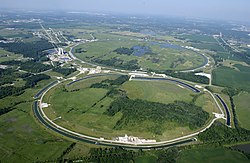Particle accelerator
| Antimatter | |
| Overview | |
| Annihilation | |
| Devices | |
| Antiparticles | |
| Uses | |
| Bodies | |
People
|
A particle accelerator, also called an atom smasher,[1] is a machine that accelerates (speeds up) particles and makes them travel at very high speeds. Accelerators work by pushing particles like electrons, protons, or atomic nuclei (the centers of atoms) with electric fields and by steering them with magnetic fields. Their main use is to study particle physics.
The largest accelerators are used to study particles smaller than atoms; smaller accelerators are used to study atomic nuclei and make radioactive materials. There are two kinds of particle accelerators: linear accelerators and circular accelerators. Linear accelerators move the particles in a line, while circular accelerators move the particles in a circle. One example of a particle accelerator is the Large Hadron Collider at CERN. It is very big, stretching through two countries. Another example is the Tevatron in the United States. The cathode ray tube, used in 20th century televisions and computer monitors is also a simple accelerator for electrons.
When accelerated particles hit other particles such as atoms, smaller pieces come out. This helps people see particles smaller than an atom. Normally those particles cannot be seen, but they can in the particle accelerator. This is because in some ways energy and matter are the same thing. At the high speed created in these machines, some of the movement energy is changed into matter. It is the opposite process that nuclear weapons use; nuclear weapons turn matter into energy. Small amounts of antimatter are also created during the process.

The particle accelerator at CERN was set up to search for the Higgs Boson particle, which would complete the Standard Model of Particle Physics.
Particle accelerators often use very advanced technology. This makes them cost a lot of money which is usually paid by governments.
Particle Accelerator Media
Animation showing the operation of a linear accelerator, widely used in both physics research and cancer treatment.
Beamlines leading from the Van de Graaff accelerator to various experiments, in the basement of the Jussieu Campus in Paris.
Building covering the 2 mile (3.2 km) beam tube of the Stanford Linear Accelerator (SLAC) at Menlo Park, California, the second most powerful linac in the world.
A Cockcroft–Walton generator (Philips, 1937), residing in Science Museum (London).
Modern superconducting radio frequency, multicell linear accelerator component.
A magnet in the synchrocyclotron at the Orsay proton therapy center
Aerial photo of the Tevatron (background ring) and Main Injector (foreground ring which is not actually circular) rings at Fermilab. The Tevatron ring also contains Main Ring and a section of it is still used for downstream experiments. The Main Injector below (about half the diameter of the Tevatron) is for preliminary acceleration, beam cooling and storage, etc.
References
- ↑ "How Atom Smashers Work". HowStuffWorks. 2001-02-05. Retrieved 2019-12-11.







